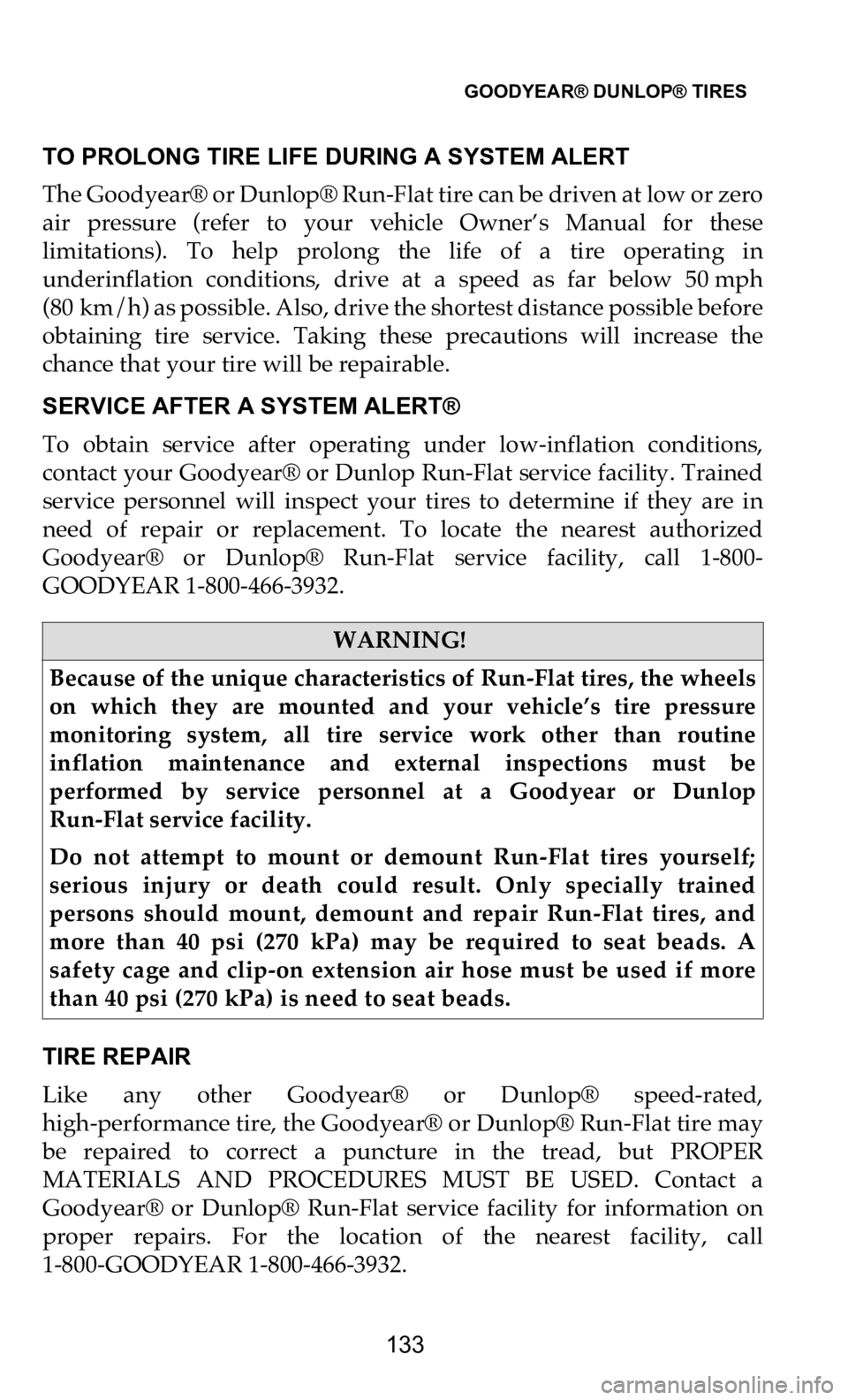run flat DODGE CHALLENGER 2021 Vehicle Warranty
[x] Cancel search | Manufacturer: DODGE, Model Year: 2021, Model line: CHALLENGER, Model: DODGE CHALLENGER 2021Pages: 262, PDF Size: 10.42 MB
Page 134 of 262

GOODYEAR® DUNLOP® TIRES
133
TO PROLONG TIRE LIFE DURING A SYSTEM ALERT
The Goodyear® or Dunlop® Run-Flat tire can be driven at low or zero
ai
r pressure (refer to your vehicle Owner’s Manual for these
limitations). To help prolong the life of a tire operating in
underinflation conditions, drive at a speed as far below 50 mph
(8
0 km/h) as possible. Also, drive the shortest distance possible before
ob
taining tire service. Taking these precautions will increase the
chance that your tire will be repairable.
SERVICE AFTER A SYSTEM ALERT®
To obtain service after operating under low-inflation conditions,
co
ntact your Goodyear® or Dunlop Run-Flat service facility. Trained
service personnel will inspect your tires to determine if they are in
need of repair or replacement. To locate the nearest authorized
Goodyear® or Dunlop® Run-Flat service facility, call 1-800-
GOODYEAR 1-800-466-3932.
TIRE REPAIR
Like any other Goodyear® or Dunlop® speed-rated,
h i
gh-performance tire, the Goodyear® or Dunlop® Run-Flat tire may
be repaired to correct a puncture in the tread, but PROPER
MATERIALS AND PROCEDURES MUST BE USED. Contact a
Goodyear® or Dunlop® Run-Flat service facility for information on
proper repairs. For the location of the nearest facility, call
1-800-GOODYEAR 1-800-466-3932.
WARNING!
Because of the unique characteristics of Run-Flat tires, the wheels
on
which they are mounted and your vehicle’s tire pressure
monitoring system, all tire service work other than routine
inflation maintenance and external inspections must be
performed by service personnel at a Goodyear or Dunlop
Run-Flat service facility.
Do not attempt to mount or demount Run-Flat tires yourself;
se
rious injury or death could result. Only specially trained
persons should mount, demount and repair Run-Flat tires, and
more than 40 psi (270 kPa) may be required to seat beads. A
safety cage and clip-on extension air hose must be used if more
than 40 psi (270 kPa) is need to seat beads.
Page 135 of 262

GOODYEAR® DUNLOP® TIRES
134
FOR SERVICE ASSISTANCE OR INFORMATION, FIRST
CONTACT THE NEAREST GOODYEAR® OR DUNLOP®
RETAILER
1. For assistance in locating the nearest Goodyear® or Dunlop®
R
etailer, look in the Yellow Pages under Tire Dealers – New.
2. Go to
w
ww.goodyear.com
for US or
www.goodyear.ca
for Canada.
For Dunlop® tires, go to
www.dunloptires.com
for US & Canada. If
additional assistance is required, call the Customer Assistance Center
at
1-800-321-2136 for US or 1-800-387-3288 for Canada.
Or write to:
Customer Assistance Center Dept 728
200 Innovation Way
Akron, OH 44316-0001
WARNING!
Goodyear and Dunlop Run-Flat tires are designed for use only on
ce
rtain original equipment wheels supplied with a properly
operating low tire pressure-monitoring system. If applied to a
vehicle without a properly operating low tire pressure monitoring
system, the tires may fail when operated in an underinflated
condition, resulting in loss of vehicle control and possible serious
injury or death. Application of these tires to a vehicle not
equipped with specified operational low tire pressure-monitoring
system constitutes improper and unsafe use of this product.
Page 137 of 262

HANKOOK TIRES
136
WHAT IS NOT COVERED BY THE WARRANTY
NON ADJUSTABLE CONDITIONS
1. Irregular wear or tire damage due to:
•
Road hazards such as punctures, cuts, snags, scuffs, carcass
b
ruises or impact breaks.
• Fire, wreck or collision
•
Improper inflation, overloading, high speed spinning, improper
m
ounting or demounting, running flat, off-road use, racing,
vandalism, willful damage or abuse
• Misalignment, wheel imbalance, defective brakes or shock
a
bsorber, use of tire chains
• Any tire which has failed as a result of adding materials (e.g. tire
f
illers, sealant, or balancing substances)
• Mechanical failure or design of vehicle
2
. Tires fitted to anything other than the original vehicles
3
. Tire worn beyond tread wear indicator (2/32 nds inch or 1.6
mm
tr
ead remaining)
4. Tire presented by other than the actual owner-user
5
. Tire branded “NA” (meaning no adjustment) or “blem” (meaning
b
lemished)
6. Loss of time inconvenience, loss of use of the vehicle or consequen -
t
ial damage
7. Ride disturbance caused by damaged wheels or after free-replace -
m
ent conditions
8. Tire with weather cracking which was purchased more than four
y
ears prior to presentation for adjustment
GENERAL EXCLUSIONS
1. No Hankook Tire employee, retailer or dealer has the authority to
m
ake any warranty, representation, promise or agreement on
behalf of Hankook Tire except as stated in this policy.
2. Tires used in racing related activities or competitive events are not
c
overed by this warranty.
3. Limitation of remedy: to the extent permitted by law, Hankook
d
isclaims liability for all consequential and incidental damages.
Some provinces and states do not allow the exclusion or limitation
Page 139 of 262

HANKOOK TIRES
138
pressure when tires are hot, use an accurate air pressure gauge to
check pressure and maintain it at the level recommended on the
vehicle tire placard or in the Owner’s Manual. Under inflation
produces extreme flexing of sidewalls and builds up heat to the
point that premature tire failure may occur. Over inflation can cause
the tires to be more susceptible to impact damage. Cold tire pres-
sures, however, should never be higher than the limit molded on the
si
dewall.
• LOAD LIMITS N
ever exceed the load-carrying limits molded onto the sidewall of
yo
ur tires or the maximum vehicle load limit as shown on the
vehicle tire placard, whichever is less. Overloading builds up exces-
sive heat in the tire and leads to early and/or sudden failure.
• HAZARDS A
void running over objects (e.g., chuckholes, rocks, curbs, metal,
gl
ass, etc.) which may possibly cause internal tire damage.
Continued use of a tire that has suffered internal damage (which
may not be externally visible) can lead to dangerous tire failure.
Determination of suspected internal damage requires demounting
the tire from its rim and examination by trained tire personnel.
• WORN TIRES N
ever drive on worn tires. Tires should be replaced by trained
pe
rsonnel when 2/32 nds inch (1.6 mm) of tread depth remain, as
in
dicated by treadwear indicators molded into the tread grooves.
Use of worn-out tires (less than 2/32 nds of an inch remaining tread
depth) increases the probability of tire failure. In most states, it is
illegal to drive with less than 2/32 nds of an inch of remaining tread
depth.
• SPEED LIMITS O
perating your vehicle in excess of lawful speed limits or the
ma
ximum speeds justified by driving conditions can be dangerous.
Excessive speed creates heat buildup in a tire, leading to possible
tire failure.
• SPEED-RATED TIRES S
peed-rated tires are identified by letters S, T, H, V, W, or Z as either
pa
rt of the size designation (e.g., HR), or part of the service descrip -
tion adjacent to the size designation (e.g., 94H) and indicates the
ma
ximum speed capability of the tire when properly loaded and
Page 145 of 262

KUMHO TIRES
144
4. The cost of applicable taxes and mounting and balancing and any
other service charges.
5. Tire damage or irregular wear due to: 1
. Road hazard, including puncture, cut, impact break, bulge,
s
nag, stone drill, collision.
2. Continued use while run flat or under acute under-inflation.
3
. Improper use or operation, without limitation, improper infla -
t
ion pressure, overloading, use of an improper rim, tire/wheel
as
sembly imbalance or other vehicle condition, worn suspen -
sion components, improper mounting or de-mounting, misuse,
mi
sapplication, fire or other externally generated heat, water or
other material trapped inside the tire during mounting, tire
alteration, racing or competition purposes, improper inserting
of sealant, balance or filler materials.
4. Improper repair, or with repairs not conforming to the Rubber
M
anufacturers Association standards, or with section repairs,
or with self-vulcanizing plug only.
5. Failure to rotate the tire at least every 5,000
miles (8,047 km) as
ev
idenced by Kumho’s Mileage Warranty/Tire Rotation Card
(printed in this brochure) or vehicle misalignment.
6. Uneven or rapid wear which is caused by mechanical irregu -
l
arity in the vehicle such as misalignment, (a measured tread
di
fference of 2/32nds of an inch or more across the tread on the
same tire).
6. Ozone or weather cracking on tires over four (4) years from the
d
ate of manufacture.
7. Tires that have been recapped, or retreaded, regrooved.
8
. Ride disturbance (out-of-round, vibration, pulling, etc.) claims
s
ubmitted after the first 2/32" of tread wear.
9. Loss of time, or use, inconvenience, or any incidental or consequen -
t
ial damage.
10. Tires that have been modified by the addition or removal of mate -
r
ial or any tire intentionally altered to change its appearance.
11. Tires unserviceability caused by the tire operation in excess of tire/ w
heel manufacturers specifications and recommendations.
Page 149 of 262

KUMHO TIRES
148
2. This limited tread wear warranty applies only to the original owner
and is non-transferable.
3. Applicable taxes and costs of mounting and balancing and any
o
ther service charges are payable by the owner.
4. The owner must rotate the tires every 5,000
miles.
5. The following are exclusions to the Limited Tread Wear Warranty: •
Tires branded "NA", "Blem", etc.
•
Tires exhibiting uneven or rapid wear which is caused by
m
echanical irregularity in the vehicle such as misalignment, (a
measured tread difference of 2/32nds of an inch or more across
the tread on the same tire).
• Tires worn-out or damaged due to: I
mproper inflation, improper mounting, uneven wear, over -
loading or off-road driving, run flat or racing, accident, fire or
ch
emicals, use on RV or commercial vehicle, vandalism or gross
abuse, defective mechanical condition of vehicle, road hazard
damage (e.g., irreparable cut, puncture, snag, bruise or impact
break) and lack of tire rotation.
• Original equipment tires on new vehicles.
6
. For staggered/split fitment applications (different size tires on the
f
ront and rear axles), Kumho Tire will cover half the number of
miles of the standard mileage warranty since these tires cannot be
rotated as recommended by Kumho.
III. ROAD HAZARD PROTECTION
Every KR21/ KU39/ KU27/ KU22 II/ KU31/ TA31/ TA11 steel
be
lted radial passenger tire that has bean irreparably damaged due to
a normal road hazard conditions (e.g., irreparable cut, puncture, snag,
bruise or impact break) within the first 2/32" of the original tread
depth (O.T.D.) and within 12 months from the date of purchase, will
be
replaced free of charge with an equivalent KUMHO tire. To be
eligible, you must present your original invoice showing date of
purchase. Tires not within 2/32" of the O.T.D. will not be issued a
pro-rated credit. Tires that reflect damage due to continued run flat or
acute underinflation are excluded.
Page 150 of 262

KUMHO TIRES
149
IV. 30-DAY SATISFACTION GUARANTEED TRIAL WARRANTY
Kumho Tire’s 30-Day Satisfaction Guaranteed Trial Warranty covers
a
complete set of four Road Venture AT51 and Solus TA71 tires. If for
whatever reason you are not completely satisfied with your eligible
tires, simply return them to the dealer where they were purchased for
replacement.
Limitations and Requirements
• This trial warranty only applies to the original purchaser of a set of
f
our eligible tires returned within 30 days from the date of purchase
and is non-transferable; any return of less than a full set of tires will
not be accepted. Original purchaser must present their original sales
receipt/invoice to their selling dealer at the time of replacement.
• Tires must be returned undamaged. Tires exhibiting road hazard,
m
ounting damage, vehicle mechanical-related problems, repairs,
improper inflation, vandalism, run flat, racing or any tires removed
from the original vehicle are excluded from this trial warranty.
• Original purchaser pays the amounts due on a new replacement
t
ire, less the amount of credit, including applicable taxes, mounting
and balancing charges and/or the cost of other services ordered.
• Tires measuring more than 1/32" of tread wear from original tread
d
epth are excluded from trial warranty.
NEW ON REAR/ROTATION RECOMMENDATION
1. Replacement of two tires: Kumho Tire recommends replacing all
f
our tires at the same time. However, when only two tires are
replaced, the new tires should be put on the rear. The newer tires,
with deeper tread, may provide better grip and water evacuation
in wet driving conditions.
2. Tire Rotations: Owners must continue to rotate tires in accordance
t
o their vehicle owner’s manual or every 5,000 miles. Side-to-side
ro
tation on "new on rear; two-tire replacements" fitments will be
acceptable.
V. CASING CREDIT
1. Casing of KUMHO radial commercial truck tires are warranted to
r
emain serviceable through the second retreaded life for 66 months
fr
om the date of manufacture.
2. KLS02a, KLD01a, and KLT02e casing warranty is valid through the
s
econd retreaded life for 72 months from the date of manufacture.
Page 165 of 262

MICHELIN®
164
Even a MICHELIN® PAX® System Tire or Self-Supporting Zero
Pressure (ZP) tire can build up excessive heat when run underinflated
for an extended period of time. The length of time and distance a
PAX® System Tire/Self-Supporting Zero Pressure (ZP) tire will
perform at low or zero air pressure will depend upon the severity of
the event causing air loss, ambient temperature, speed at which the
tire is operated, and the conditions under which the tire is operated
(i.e. hard braking, cornering and other sharp maneuvers will greatly
reduce the length of time the tire can perform at low or zero air
pressure.) Continuous use of an underinflated tire may lead to sudden
tire destruction. If a tire at low or zero pressure begins to vibrate or
cause difficulty in vehicle handling, remove the tire immediately and
replace with the temporary spare. If Michelin® PAX® System Tire/
Self-Supporting Zero Pressure (ZP) tires are supplied as original
equipment, refer to the vehicle owner’s manual for complete details
on the low tire pressure warning system designed to alert you in the
event of a low pressure condition.
NOTE:
MICHELIN® SELF-SUPPORTING ZERO PRESSURE (ZP) TIRES
AR
E TO BE USED ONLY IN CONJUNCTION WITH AN OPERA -
TIONAL, MICHELIN® APPROVED, LOW TIRE PRESSURE
WA
RNING SYSTEM. Otherwise, all provisions of the limited
warranty are void. For a list of approved systems, see your partici -
pating Michelin® tire retailer, or call toll free:1-
800-847-3435
NOTE:
Some MICHELIN® Self-Supporting Zero Pressure (ZP) tires can only
be
mounted on special SH-M (Symmetric Hump - Modified) wheels.
These tires bear the special SH-M designation, molded into the side -
wall of the tire, next to the ZP designation. DO NOT MOUNT A TIRE
WI
TH THE SH-M DESIGNATION ON THE SIDEWALL ON A
STANDARD WHEEL. DOING SO VOIDS THIS LIMITED
WARRANTY AND COULD CAUSE THE TIRE TO BECOME
UNSERVICEABLE AT LOW OR ZERO PRESSURE, RESULTING IN
SERIOUS PERSONAL INJURY OR DEATH.
NOTE:
MICHELIN® PAX® SYSTEM TIRES ARE TO BE USED ONLY IN
CO
NJUNCTION WITH AN OPERATIONAL, TIRE PRESSURE
MONITORING SYSTEM (TPMS), APPROVED BY THE VEHICLE
MANUFACTURER FOR USE WITH THE PAX SYSTEM. Otherwise,
Page 166 of 262

MICHELIN®
165
all provisions of the limited warranty are void. For a list of approved
systems, see an authorized PAX® System retailer, or call toll free:
1-877-PAX TIRE or 1-877-729-8473
For all types of tires, consult your vehicle tire placard or owner’s
ma
nual for recommended operating pressures. If the tires are
purchased as replacement tires, operating instructions for the low
pressure warning system will be provided by the manufacturer of that
system. Recommended operating pressures will be provided by a
participating Michelin® tire retailer for self supporting ZP tires.
Recommended operating pressure for PAX® System Tires will be
provided by a PAX System retailer. These inflation pressures must be
maintained as a minimum. However, do not exceed the maximum
pressure rating indicated on the tire sidewall.
CHECK THE COLD INFLATION PRESSURES IN ALL YOUR
T I
RES, INCLUDING THE SPARE, AT LEAST ONCE EACH
MONTH
Failure to maintain correct inflation may result in improper vehicle
ha
ndling and may cause rapid and irregular tire wear, sudden tire
destruction, loss of vehicle control and serious personal injury.
Therefore, inflation pressures should be checked at least once each
month and always prior to long distance trips. This applies to all tires,
including sealant types, and Self-Supporting Zero Pressure (ZP) tires
which are as susceptible to losing air pressure as any other type of tire
if not properly maintained.
UNDERINFLATION
It is impossible to determine whether tires are properly inflated by
si
mply looking at them. It is almost impossible to “feel or hear” when
a tire is being run underinflated or nearly flat. Tires must be checked
monthly with a tire pressure gauge.
Pressures should be checked when tires are cold, in other words,
be
fore they have been driven on. Driving, even for a short distance,
causes tires to heat up and air pressure to increase.
Checking pressure when tires are hot:
If pressures are checked after tires have been driven for more than
th
ree minutes or more than one mile, (2 km) the tires become hot and
th
e pressures will increase by approximately 4 psi. Therefore when the
tire pressure is adjusted under these conditions, it should be increased
to a gauge reading of 4 psi greater than the recommended cold
inflation pressure.
Page 168 of 262

MICHELIN®
167
instructions for checking pressures when tires are hot. When tires
have cooled, check air pressure again. If any tire has lost more than
5 PSI from the previous pressure check, have the tire inspected at
once by an authorized PAX® System Retailer for PAX® tires or a
participating Michelin® tire retailer or representative of your
vehicle manufacturer if your vehicle Owner’s Manual so advises.
Failure to do so may cause irreparable damage to the tire and result
in sudden tire destruction and personal injury.
TIRE PRESSURE MONITORING SYSTEMS (TPMS):
Your vehicle may be equipped with a Tire Pressure Monitoring
Sy
stem (TPMS) that is designed to monitor the pressure of tires
mounted on your vehicle and sends a signal to the driver if a tire
pressure falls below a predetermined level. A TPMS should not
replace monthly manual pressure checks for all four tires and the
spare. We recommend that you manually monitor and check tire
pressure inflation with a pressure gauge. Your tires should have the
recommended pressure listed by your vehicle’s manufacturer. This
information can be found in the vehicle Owner’s Manual and often on
a placard located in the vehicle’s door jamb, inside the fuel hatch, or
on the glove compartment door. If you have a plus size fitment that
requires a higher inflation pressure, your tire pressure monitoring
system will require re-calibration to new inflation pressure. Refer to
your tire dealer/installer of plus size tires for proper inflation
pressure.
We recommend checking air pressure once each month, and before a
l o
ng trip. Whether you have a full-sized or mini-spare, make sure that
it is properly inflated as well. If the TPMS generates improper
monitoring or signals we recommend that you consult your Owner’s
Manual provided with your vehicle and follow-up with your vehicle’s
manufacturer.
TIRE SPINNING
Do not spin wheels in excess of 35 mph (55 km/h) as indicated on the
sp
eedometer. Excessive speed in a free-running, unloaded tire can
cause it to “explode” from centrifugal force. The energy released by
such an explosion is sufficient to cause serious physical injury or
death. Never allow anyone to stand near or behind the spinning tire.
When in mud, sand, snow, ice or other slippery conditions, do not
en
gage in excessive wheel spin. Accelerating the motor excessively,
particularly with automatic transmission vehicles, may cause a drive